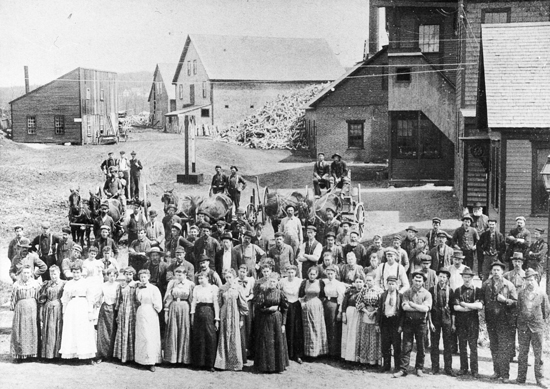B A C K T H E N
Bragged-up Stud Racer

Portland, 1890s. Mansfield’s Livery Stable, Lafayette Street, Munjoy Hill. Note the children posed in a chair, and the black hostlers; Munjoy Hill was home to most members of Portland’s African-American community. At the turn of the century Portland supported nearly fifty livery stables, in addition to those kept by hotels and stable-owning businesses. By the early 1920s nearly all were gone, with Mansfield’s and Thomas’s stables (also on Lafayette Street) the most notable survivors. A visitor at Thomas’s in 1923 noted stored away in the loft a grand assort-ment of wagons, buggies, phaetons, cabriolets, station wagons, hacks, pungs, Victorias, and more, now “of no practical use [but] not yet antique enough to be valuable as curios.” Thomas’s had been the livery for the wealthy. Commercial travelers, businessmen, and assorted horseless social climbers concerned with appearances were beholdened to cooperative livery men.
Many stables “stood” a bragged-up stud roadster. Many doubled as sales stables. Some were associated with stage lines or hack services. Some boarded privately owned horses and, as a “repository,” stored (and sold) carriages and sleighs. Stables in market towns did a big business “baiting” the horses of visiting shoppers. Many owned a large excursion “barge” mounted on runners or wheels, depending on the season, wonderfully painted, and bearing such names as Mayflower, Triumph, or Nonesuch. Before street cars, Portland barges took picnic parties to the Cape Elizabeth seaside. Robinson’s stable on Forest Avenue had a barge in the shape of a vessel that seated forty and was armed with wooden cannons.
Some kept a team of fancy black hearse horses—nothing brought greater joy to the heart of the liveryman than did a good funeral. The bread-and-butter business of a “straight livery,” however, was rentals. Since relatively few people owned horses, the waiting list for a weekend rental might well be a matter of weeks. Aside from the shining trotters and pacers kept for favored customers, most rental horses, to lessen liability, were safe (if cynical) iron-mouthed plodders. Although a good snowfall brought a rush of business, summer was the busiest season. Humane officials were particularly concerned for the welfare of resort horses, which were unlikely to be properly conditioned for the hard task of hauling about heavy-handed vacationers in hot weather. College-town horses also often suffered from being overdriven.
A stable did nothing to adorn its neighborhood. A dark and pungent firetrap, it attracted English spar-rows, flies, rats, cats, and loiterers. Horses stamped their feet through the night, and the hogs who recy-cled oats in the manure cellar noisily squabbled and celebrated when the early morning offerings were dumped through the scuttle into their cellar. The strong ammonia fumes that dulled the paint of car-riages were said to aid consumptives, who, for that reason, sought employment in stables.
Fire was a frequent horror. A July 1885 conflagration began in the haymow of a Belfast stable, where three inebriates had gone to sleep off one too many. Two of them lost their lives. Also lost, in addition to the building and most of its horses, were forty tons of new hay, carriages, harnesses, robes, and so on. Before the fire was extinguished—thankfully the night was still—sixteen businesses were burned out. Losses of $50,000 were caused by fifty cents’ worth of rum.
Nearby was the stable attached to the American House, in which there were eleven horses, which added to the livery stable made some twenty-five horses in number. It was impossible to rescue the poor beasts and twenty-one of the number literally roasted alive. The spectators said it was heartrending to witness the struggling of the horses, and their cries were pitiful and could be heard blocks away. –The Republican Journal. July 16. 1885.
Twenty hogs also died in the hotel stable cellar. Chemicals in Tuttle’s photographic studio went up with a satisfying eruption, while rum from barrels rolled out of the American House was passed about in buckets. Tall beaver hats a quarter of a century old, taken from a burning store, were worn about the streets. “We [at the Journal] have not heard of anyone throwing a looking glass out a window, but take it for granted that it was done. This is a feature of every fire.”
Text by William H. Bunting from A Days Work, Part 1, A Sampler of Historic Maine Photographs, 1860–1920, Part II. Published by Tilbury House Publishers, 12 Starr St., Thomaston, Maine. 800-582-1899.
